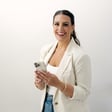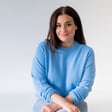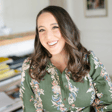Become a Creator today!Start creating today - Share your story with the world!
Start for free
00:00:00
00:00:01

Episode 231 - How to Choose and License Typefaces (Fonts) with Jen Wagner
In today’s episode, I’m chatting with type designer Jen Wagner.
Jen is one of the most talented type designers around and not only do we use one of her fonts on our own site, we’ve also licensed several of her fonts for our templates.
As always, links and resources can be found in the show notes. Check ’em out at https://daveyandkrista.com/how-to-choose-license-typefaces-fonts-jen-wagner-btb-231/ And if you enjoyed this episode, please consider leaving a review over at Apple Podcasts.
Transcript
Unexpected Font Combinations
00:00:00
Speaker
Maybe there's a combination that would completely surprise you that you would never put together and then you end up just stumbling on it and it just works. You're listening to The Brands That Book Show, a podcast for creative entrepreneurs who want practical tips and strategies to build engaging brands and craft high converting websites.
Introduction and Guest Overview
00:00:21
Speaker
We're your hosts, Davey and Krista, co-founders of a brand and website design agency specializing in visual brand design and show it websites. You're listening to The Brands That Book Show.
00:00:31
Speaker
In today's episode, I'm chatting with type designer Jen Wagner. Jen is an independent Nashville based type designer known for her authentic and candid approach to type design and business. The attention to detail and quality of her typefaces reflect our core belief that beautiful types should be available to as many creatives as possible. With nearly a decade of experience, she has cultivated a reputation for crafting obsession worthy typefaces that resonate deeply with designers of all kinds and skill levels. Jen is one of the most talented type designers around, and not only do we use one of her fonts on our own site, we've also licensed several of her fonts for use in our templates. We dive into the basics of font pairings, choosing the right type for your project, as well as different licensing situations and when to use the various licenses gen Jen offers. Designers prepare to fall even more in love with Jen and her work. And even if you're not a designer, chances are that from time to time, you still need to pair different fonts together or look into purchasing licenses.
Jen Wagner's Design Philosophy
00:01:27
Speaker
And now on to the episode. Jen, I am so excited to be chatting with you today. I've been a fan of your fonts for a very long time. They are among my favorite fonts to use. And I feel like whenever we use them in our designs or we have licensed some for our templates, it just like elevates the work so much. So thank you for being here with me. Thank you for having me and for using my fonts. I use them so beautifully anytime I see your work. Oh, thank you. So I'd love to know a little bit more about your story. Like, how did you get started as a type designer? Because I feel like that is like such a unique niche. And I remember being in design school and learning that that was such a thing. But I just remember thinking that would be way too hard to actually design fonts. So can you tell me a little bit more about your story?
00:02:15
Speaker
Yeah. Well, it's it's funny because my experience is just so
From Marketing to Type Design
00:02:19
Speaker
opposite. Like I did not go to school for design. I went to school for marketing. Okay. And so all of the design stuff has been up until recently self taught. And so when I got into type design, I just like, I kind of Stumbling into it is like being gentle with it. I kind of like face plant it into it but Were you a designer at all prior to that or like did you go from marketing to any sort of design? Well, yeah, so I was I was doing design mostly and like I was working we we my husband and I worked for a big church at the time so I was their creative director and main graphic designer and had kind of like come into that through learning design through high school and being part of like a From the time I was 15, I was doing design for different people, whether it was that church or it was actually used to trade t-shirt designs for membership credits in high school.
00:03:13
Speaker
So like but my National Honor Society credit on my transcript, like I didn't go to any of the meetings. oh Oh my gosh. But they marked me attended because I like, that was the trade. Like I'll design all your t-shirts and you just say I attended these meetings and we'll be good. That is so smart. Smart, ethical, you know. That was one of the only, i was I was kind of a moral police in high school. So I'm a little shocked in hindsight that I ever did that, but. Yeah, it's okay. It's okay. So I was doing a ton of design. I started to get into freelance and ended up quitting my full-time job to go freelance full-time because I was just like, I mean, I was working constantly, had enough freelance to feel like I could make the jump. And then as soon as I made the jump, I fell hard where like all but maybe five to 10 hours a week of the 50 that I had just bounced.
00:04:07
Speaker
And so i I just didn't have any work anymore. So I spent the next seven months or so, six months or so, you know, starting different Etsy shops, trying to find freelance work wherever I could. I ended up applying for different marketing positions. The job market at the time, it was 2016. So that was a little bit of a weird stage and I wasn't able to get any jobs. And it was just like an extraordinarily stressful time. And so I was spending all of this energy trying to find ways to bring in income.
Success on Creative Market
00:04:38
Speaker
None of it was working. And I was stressing myself out and my husband was like, okay, none of this is working. So let's just like accept that none of this is working right now. And I was in the middle of this big interview process for a marketing position and he was
00:04:50
Speaker
Like, okay, why don't we take the time that you're spending with these interviews? It was gonna be like three weeks in different interviews and stuff and I just had like this huge gap in between where I wasn't doing any work. It's like, just take this time, stop trying to make money because you're interviewing for a job. Like, stop worrying about the money and just make you wanna make. for yourself. And I'd always been really curious about type and had the year prior i' been getting into hand lettering and calligraphy and was doing invitations. And that was kind of like the premise of the Etsy shops I was trying to start. And a friend of mine recommended this plugin called font self for Adobe Illustrator. And you can basically design your whole character set in Illustrator and then click and drag it into this plugin window and it'll assemble the font for you.
00:05:38
Speaker
That's very cool. It was so cool. So I was able to just play and i did I was able to kind of skip over the technical side of having to learn how to put this thing together and just focus on like, well, what do I need in the projects that like I am getting or would like to be getting and I'm not able to find out there. And so I started making these just very simple, minimal, all caps, limited punctuation fonts and throwing them up on creative market during this like interview process, like weird standstill where my hope, and this is so silly, my hope putting these on creative market was to make enough money to pay the water bill and to eat at Chipotle once a week.
00:06:24
Speaker
Those are great goals. It's great goals. It was like 80 bucks a month. Like I want to make, I wanted i just want took anything to come in. Right. And it worked. Like it something about it just clicked and I ended up within the next couple of months making more than I did at my full-time job. That's amazing. And that just became the thing. So that's how I found you through Creative Market at first because there's like, there are a lot of bad fonts on Creative Market and I feel like yours really stand out. but well and and Honestly, some of them are probably mine. right like The stuff that I started with was very like rudimentary. like it just ah yeah you know We all start somewhere and i actually I do like to keep that work up because I think it's important for other people to see that. like yeah Oh, eight years ago, this is what her stuff looked like and that's why it's $12.
Font Creation Process
00:07:17
Speaker
Well, that's good. I like to retire my designs, like our templates that are just feel like old and outdated. So I understand that too. I think it's cool that you have like both out there. Yeah. Sometimes I wonder if that's a wise move, but at the moment I ah feel a little attached to them still. yeah Have you thought about bringing them back and like reviving them in a fresh style? Cause sometimes I do that too. And I give it a new name. I've thought about it just with releasing updates or expansions. And at the moment I feel like that time is better invested into new work or yeah expanding.
00:07:51
Speaker
More popular items that are more current like I just did an expansion on perfectly 90s And I think that was more worthwhile than going back and redoing capri from yeah teen and that makes sense Yeah, so how do you come up with ideas for new fonts cuz like you release them fairly frequently is that right? Oh Yeah, not nearly as frequently as I did. I think yeah part of that is just the added complexity of like now we're doing families and italics and it's a lot more complex than it used to be. So I shoot for like four to six releases a year. And the inspiration really depends. Sometimes it can come from like
00:08:28
Speaker
like I remember last summer I was cutting up a watermelon and something about the way the lines inside the watermelon like branched out to the the rind like curled out like this really cool, why can't I remember the name of the style? It's an Italian style of like a serif. And it looked just like that, and I was like, oh my gosh, that is so cool. And it didn't end up going anywhere, but I did experiment with it. So there are different things like that, or different you know architecture, or there are even times where like I'll be doing a mock-up for one of my typefaces and kind of feel the need for a certain typeface or a certain style and be like, oh, I don't have that.
00:09:09
Speaker
maybe I should make something that would like fill that need. How would my version of this work and look and and feel different? so It can come from different places. but Yeah, that's really cool. Because I know sometimes I spend hours and hours trying to find the most perfect font for a project, but I think it's really cool that you have the ability to create a font. Yeah, it's a lot of fun. And I really appreciate that you have like the font families and the variations in like weights and italics because there are a lot of fonts out there that I feel like just don't have all of those variations and it makes it harder to use them.
Education and Professional Growth
00:09:43
Speaker
Yeah. Well, and that was, that was kind of the main shift in my business, like around 2022, I believe.
00:09:53
Speaker
I had, up until twenty twenty the end of 2020, been completely self-taught in type design and was kind of reaching my cap of what I was able to do. There weren't many resources to learn online. You had to go physically to college. And there were only like four schools in the US that I knew of that had specific type design programs. okay And it was just a very intense process to even think about. So I was kind of like, do I need a career switch? like what do i do and ended up finding these two programs there is a type of cooper in new york and then type paris in paris they had started doing the six week condensed programs.
00:10:37
Speaker
where they take their year-long extended program and you're working 15 hours a day, six days a week, but you're getting all that information out at once. And so I applied to both of those programs at the end of 2019, got into both, which was amazing.
Building a Font Foundry
00:10:52
Speaker
And as we were deciding which one to do, the world shut down.
00:10:58
Speaker
So of course I was devastated, but then and Type Cooper ended up moving their program online and it had only been in person up to that point, even the year long one. So okay it ended up being really wonderful. I was able to get the insight from the most amazing teachers to like kind of get me past that block of like, I know this looks wrong and I have no idea why. yeah And I have no idea how to fix it. So that really took my work up a level and also gave me the skill I needed to feel capable to start developing multiple weights and italics. And I think that that was like kind of the start of the new Jen Wagner Co. Like I moved from this like creative market kind of standard to now like feeling like a foundry. And the desire to have that versatility of the multiple weights and everything is just like, it's it's special to have that now.
00:11:55
Speaker
And did you have kids at the time you were looking at that internship? Because I know you have kids, isn't it? No. OK. Because I'm like, how do you go away for six weeks? I know. Well, we were we were both going to move to New York and do that. And then in 2021, we had our our first son. And then last year, we had our daughter. So okay it would be very difficult now to to do six 15-hour days and leave the kids. Oh my gosh. But it's not outside the realm of possibility later. Just not today. yeah
00:12:27
Speaker
So we talked about just like your variations and fonts. So one of my students, we teach a design course. Why is it that a beautiful font can change someone's perspective of the graphic or website the font is being used on? So like she wanted to know more about the psychology of a font or type. That's a great question. I am not super well versed on the actual psychology behind it all, but I think it resembles anything that inspires us or connects us to art or emotion or anything like that. Like why does a material and or a pattern on a dress move you? Why does the way it flow move you? Like why? I think that so much of it is like,
00:13:12
Speaker
When the typeface feels visually and emotionally aligned with the vision of the brand or the the the graphic, whether it's the photography alongside it or any of that, it creates this like cohesion and unity and this pulse. And I think that that is why like when you find the typeface that feels perfect, and I think that the word feel is the most common thing I hear. It's not that it looks perfect, it feels perfect. like Something about it moves you and it gives your work a pulse and it electrifies it. And so I'm not sure if it
00:13:53
Speaker
if I know anything technical about the psychology, but I do know that like the way it feels is similar to to any beauty. Like yeah it moves you. And I think it's worth looking until you find something that like kind of gives you that jump in your stomach. It's like, Oh, This is it. Like I found it. Yeah. I think part of it too could be just like, like thinner and more delicate details tend to feel more high end and they tend to point you towards a certain aesthetic, like more bold things tend to be more loud and in your face. So I don't know if that answers her question too. That's like what my brain goes to when I think about like, how does this a font shift someone's perspective?
00:14:36
Speaker
Yeah, that makes sense. and And I would totally agree with that. Like serifs are usually associated more with luxury and, you know, the high end or, but it depends on the type of serif too. Like it could if it's delicate, then maybe it's that. If it's like a chunky block slab serif, then maybe it's a little bit more playful or you've got like Cooper and that's such a playful, fun, chunky, bold serif that in other contexts can like, go crunchy and like granola and feel feel organic and it's like typefaces are just
00:15:13
Speaker
they're
Font Pairing and Design Principles
00:15:14
Speaker
remarkable. They're shape shifters. Like depending on what environment you put it in, it can completely change the tone. And so it really just like, it depends on what you set it with, but there are like those kinds of ground rules. Like if it's really bold, then maybe it's more playful or like as attention grabbing and the, the more like higher contrast thin delicate ones may communicate luxury. Like there are, there are different things, but I don't know how many rules there actually are because as soon as you put it in and and a different environment, it's like cooking. Like olive oil doesn't always taste the same. And I mean, there are a million different types, but like also what you put it with then like or wine like or coffee. Like you can have a bite of a cinnamon raisin bagel before you take a sip of coffee and your coffee will taste completely different than if you'd had a bite of a banana before or something. right right It all just changes. I think that's a good answer. I hope so.
00:16:10
Speaker
It's such a non-answer. It's like, oh, it depends. No, that's okay. I mean, art is subjective and I think that choosing a font face, choosing type is like an art. So yeah. Could you share some general tips for how to find fonts that look good together? And I think that you might have a free guide that we can link to in our show notes if you want to talk about that. I do. so so the The free guide, it's like it's pretty simple and brass tacks, but goes through the general principles I use and then has nine of my favorite pairings at the moment. and Some of them are mine, some of them are Google and Adobe fonts. like It's just got a variety. That's a great resource to start with.
00:16:51
Speaker
What's covered in there is basically like i mean it's just the basics like you got it's all of your main considerations which end up being like. Your contacts like what is this typeface being used for even physically like is it going to be printed what size is it going to be printed out. Is it going to be used in long form text like a book or a magazine or something? Is it going to be just in short form? Is it going to be big headers, short sub? like There are so many different contexts and things to consider. And so that's like where I usually start.
00:17:27
Speaker
Because if I know that like this logo is going to be used on print, and it's going to be like printed on a label at really small scales, then the super high contrast font that I'm in love with might not work. right Or you might just need a variation on that mark that works better at small scale, and that's the possibility too. So context is probably the primary consideration to start. You got to know what you're using it for. and then I like to think about my hierarchy and my contrast. So, yeah, what are these typefaces being used for? And like, where are you wanting people's attention to go? And what are you trying to communicate? And how are you trying to communicate that? Like, what do you want? How do you want these words to feel? Like, I love to say that the written word is what we say and type is how we say it.
00:18:21
Speaker
I love that. i get thanks like It gives text a voice and sometimes that voice is wrong. like any warning printed out in Comic Sans, like that's the wrong tone of voice. Like you don't, that's not the right voice to use. But I don't know. I think that like considering, yeah, what you're trying to say, like making sure the visual hierarchy is aligned so people know like, oh, this is the the big important thing. Your type can communicate that.
00:18:54
Speaker
And then anything below that that is like expanding on the big thing may be a different type that visually creating that contrast helps your brain be able to say, like oh, this is really important and I can maybe skip over this stuff or go back to it if I have other questions. like You're prioritizing information for people with your type and with your sizes too. I think that's one of the reasons why I love earphones because they have the italic versions and the different weights so that if you do need like the smaller little bit of text, you could make it italics or even bold if you're doing it at a smaller size. So I appreciate that. Yeah. Thanks. I'm so i'm so glad the versatility is helpful. It really means a lot. Yeah. Yeah. So those are big. And then I think like,
00:19:38
Speaker
I love the contrast. so like I love pairing a serif with a sans. It's just the easiest default thing to do. But at the same time, like you can't just pair any sans with any serif. They need to speak the same language. I had to wear Crocs the other day, like for a company retreat event, a retreat that David and I were at. And one of my friends was like, hey, you're not wearing the Crocs right now. And I was like, it's the lines. Like they're circles, like they're circles and they're heavy down at my feet. And the rest of my outfit is more like asymmetrical and like it has more some angles. And so I was like, I can't pair like the heavy circles like low on my body and then have like this asymmetrical dress. It just doesn't work.
00:20:22
Speaker
And so I think that it's similar in all art, but I think it's similar. That is perfect. yeah Yes. Yeah. Like there are some things that you can wear together and some things you just can't. v And I do think that like that's part of the challenge and the fun of pairing type. Like you have to try things on and you have to actually see them together to know for sure. Sometimes, because sometimes like you might think something goes together and then when you put it there it's like, oh, that's just not right. Maybe they seem too similar. You still want some amount of contrast to keep things interesting, but maybe there's a combination that would completely surprise you.
00:21:05
Speaker
that you would never put together and then you end up just stumbling on it and it just works for the brand that you're working on or the visuals or whatever it is you're creating. You really don't know until you just play. Yeah, I do a lot of like testing on your site with like your font, you can preview the fonts, you can text them, type them out and then do a screenshot and like pair it like in Photoshop or I use sketch a lot just to like see how they visually go together before I commit and buy something. So if you've never tried that before, that's a way to test.
00:21:36
Speaker
Oh, I know that would be a great tool. I'm trying to like get with my developer on something like that, actually. And maybe we can cut this out because I don't know how official it's if it's going to happen. But I would love to develop a tool like that on my website where you can just pick two fonts or three and and yeah they look in your headers. And I just ah I would love that. That sounds really cool. Also, you mentioned Comic Sans and you will appreciate this story. So my husband Davey has been getting tattoos recently and a couple weeks ago, he was having a bad day when he comes down from the office like midday on a Thursday and he's like, I'm going to go get a tattoo.
00:22:13
Speaker
I was like okay cool when like right he's like now my husband has done that to me so many times ah you understand and I was like do you know what you want and he's like yeah I have an idea I'm like okay just like don't get a lot of color cuz like if you have lots of colors they might not be the right tones I don't know if you and the tattoo artists you're gonna pick the right tones And so a couple hours later, he texts a friend and I, and he's like, all right, I'm going to get that tattoo. He's like, I don't really love the font, but I think it's going to be okay. And I was like, hold on, wait, you're going to tattoo a font that you don't love on your body forever. It's like, you cannot do that. And then I was like, I need to see a picture. And he texts it to me and he, it's like this sailboat from Luke.
00:22:55
Speaker
And it has Latin in this like flag that says, Duke in Ultim, which is cast into the deep. When I kid you not, it's Comic Sans font. And I was like, you cannot put that on your body. Like, just move this there. Like, do you want me to pick something for you? Thankfully, they changed it. And it was not on his body. But like, I think they were there. No, I wasn't there. He texted me a picture. Well, I mean, like, like yeah there to save him. I was like, you can't do that. Like, I'm a designer and I will die if you have that on your body. So thankfully it is not there, but it was almost there. And I figured you mentioned Comic Sans, you would appreciate that like horrible almost mistake. Not the right voice. Not the right voice. If it was in a comic book, sure, but not on your body. It just becomes a joke.
Understanding Font Licensing
00:23:41
Speaker
Now it's a joke tattoo. It is. It would have been so funny.
00:23:46
Speaker
Okay, another question. I get this question a lot from other designers. Can you talk about different font licensing? Because I feel like you do such a good job with this. I've actually sent your page to show its team before to help them understand how to explain it to other designers. Oh, that is extremely like I'm so happy to hear that because i I feel like there's so much more clarity that needs to come. No. And i do it it's so hard. It is. like And the more contexts are become available online, that the trickier it gets. Do you want to talk through like some of the basic licenses and then how you would use that licensing? And this ah also, I think, is just for you. Not all designers allow the same use cases that you do. Totally. So I'll put that ah ahead of time.
00:24:32
Speaker
Yeah, so I do like a context model, basically. So depending on what you're using the type for, you'll need a specific license for that use. There are other foundries that do like a company size model, where the license is more expensive, but you just don't have to worry about it. Like if your company grows, then you buy more licenses. But like if you're just one to five, you pay the same rate and you can use it for whatever. Right. So different models, of course, work for different people. I am more context focused. So like I generally, my basic ones are a desktop license, web, ePub. So that's like for your eBooks, any kind of ePublication apps and templates. And I am pretty sure that's it.
00:25:19
Speaker
That sounds right to me. I feel like I've seen four. So your desktop will cover just about anything physical. So that covers for me, it covers unlimited products, merch. If you want to print merch, you can use it on your labels. You can use it on your hang tags. You can use it for your logo. You do not have to buy a logo license from me to design a logo. Like you're set with a desktop license. Do some people require a logo license? I don't know if I've ever seen that before. Yeah, I don't know if they still do. I know that VJ type, I think that's what they are. They had a logo license for a long time and there are a bunch of other foundries that do. And I also, I know that so many designers are frustrated by that because they're very expensive licenses too. On the flip side, it's a really helpful filter for making sure that you don't flood the market with logos that look the same.
00:26:16
Speaker
So it is a little bit of a control in the the market that can help and be really valuable for some designers to be like, Hey, I know that this isn't going to be something that is going to be everywhere all the time in this context. So frustrating on one hand, but also very helpful in another. So yeah, it depends on what you're looking for. Yeah. So you can use it for logos with me. And then that use also covers like, I mean, any desktop programs, which now encompasses Canva. and Figma and those like online programs that function as a desktop program.
00:26:51
Speaker
The tricky part with that though, gets into sharing designs. So if you were to share a template for sale that you designed in Canva, or I mean, even that you designed in a desktop program, like when you're sending that file over from a desktop program, like an InDesign template, if the typefaces aren't in the download folder and they're not present on the desktop, they're not gonna have any access to them. So it is what it is. On the other hand, if you share a template from show it or Canva, I'm not sure about Figma yet, but it will include the typeface in those files. And that's where things get really tricky and really murky. A desktop license absolutely does not cover that.
00:27:40
Speaker
And it's basically one seat per license. So if you know I have three computers, but I'm the only one using those three computers, then I only need one desktop license. But anyone else who has access to the files needs their own license. So if you're sharing a template for sale, now all your customers have access to use this font as if they own it, and they don't own a license for that use. So that's where template licenses come in. And you can buy a template license from my site where for each product you offer for sale or each template you have for sale, you can license the font for that product and then your customers are free to use it. Which I love that template. Yeah. I love that you do that because not all type designers allow that. And I really think it makes a stronger like quality of design.
00:28:32
Speaker
So I didn't do that when I was just getting started. It felt like a really big investment. But once I figured out which products our audience was going to like, I started making that investment. And I feel like it was really worth it. So if you are a template designer or you want to be like, know that that's an option. And I think in a lot of cases, if you know you've kind of proven your concept, you figured out what your audience resonates with, I think it's probably worth it.
Valuing Quality Fonts and Future Projects
00:28:55
Speaker
I agree. I mean, it's such a tone changer, you know, and People really, I mean, it's the same thing I encountered as a designer of type. Like I think that users of type can feel the same thing or even like viewers of type. You don't have to be a professional to look at a typeface and see like something about this feels off. I don't know what and making sure you're using quality type can elevate some things in such a subconscious way.
00:29:26
Speaker
that I think it's absolutely worthwhile. yeah i mean Even today, i was just I emailed Death to Stock to see if I could license some of their imagery for a template because imagery is so powerful. and like How much more compelling is a set of beautiful images than a grayed out you know insert photo here box? Like there's so much value that you add to your audience and giving them something that like when it's delivered, it's inspiring, not just like when they're looking at the photos of it on your website. Yeah. I think it gives them a guide too for how to use it in the future. So yeah, absolutely. Agreed. like Okay. yeah This is more of a fun question. Do you have a favorite font from your designs? i Like choosing a favorite title, probably.
00:30:14
Speaker
You know, it's really funny because I feel like my favorite child is always the one I'm pregnant with. Like I, I'm working on a new serif right now that I love so much. And it's the common, you know, designer conundrum where like your next project is always your best project. And you learn so much every time you do something that your work just continues to evolve and grow. And yeah, so at the moment it's the next one, which is unnamed at the moment, but it's a really beautiful, like romantic,
00:30:49
Speaker
Sarif and it it'll be a whole family with italics and it's got these like oh, it's so pretty Actually, it was funny. It started off as a design sprint with Jen from tonic. Okay, who we kind of talked about it like creative directing together for the Fitzgerald template and it just didn't quite fit so she moved forward with like the one that did which I'm so glad she did like I would much rather I anybody use what like works best for the design? like right I'm not offended. Let's do what works best for everything and right and for the vision. So it started off there and then ended up like kind of going a little wayward in like my creative direction, but it's still just so romantic and it's got these like swoopy capitals and I'm wanting to like
00:31:42
Speaker
maybe explore. Right now it's just the R and the K kind of swooped down on the italic, but I'm like, what if all of the italic uppercase had some kind of pretty swash? And what if it's just growing and growing? but it's I'm very excited about it. I can't wait to see it. I feel like there are a lot of like overused romantic serifs out there, so I'm excited that you're adding another one. Perfect, good. I'll have to give you a little peek after this. I'm very excited about it. That's exciting. Okay, so if somebody is interested in learning more about you and seeing your work, where can they find you?
00:32:15
Speaker
Just, you know, the general places. I'm on Instagram. I will occasionally pop into TikTok. Like I pop into a gas station to buy a Diet Coke. Like it's a very like occasional thing, but sometimes I'm over there. Yeah. But usually it's just Instagram. My website is genwagner.co. Same with my Instagram. And you can find me there. You have a lot of really fun tutorials on your Instagram. So I definitely think you're worth following. Oh, good. I'm so glad. but I want to do more. They're really fun. Yeah. I loved seeing them. I know they probably take a lot of time to create. So there's probably like that offset of like working on your actual products and then creating the Instagrams. So. Oh gosh. Yeah. Well, isn't that just like the story for all of us? For everybody. Yeah. We like look down at our clock and we're like, I have spent half of my work day making this real. Yeah. That we'll get maybe a couple thousand views and like,
00:33:11
Speaker
Oh, we could, that's a whole other side track of like being intentional with your social media. And like, it is it is something. Yeah. We have somebody who helps us with all of our marketing and we're going to share our content strategy. We're going to record a podcast soon about it, but please do. Yeah. Basically we have a different content focus every quarter. And this month or this quarter's was supposed to be tick tock. And I was like, I don't think it's worth it. I think we're just not going to do tick tock. So yeah, it's hard. Yeah, I'm someone who falls in that camp. I'm like, I really don't. I think the design community on TikTok is so strong. I just don't know how to engage there. like yeah And I don't know when you're like a solo, basically, like I do have a VA and she's amazing, but like, How worth it is it to like learn how to do something really well? right If I'm going to be on TikTok, like on TikTok, I want to be really good at it. And there's a way to be really good at it. And I just don't know if I like, it's a lot to learn. It is a lot to learn. I'm also feeling old for TikTok. I don't think I am, but still, I feel old. ah I do too sometimes. I've heard that like ankle socks are out.
00:34:23
Speaker
okay either' They're like a millennial thing. They are. But I just, my ankles get hot. Like I don't think I could have like the Gen Z socks. I know that makes me look, shows my millennial age, but I think it's okay. You're on the East Coast, right? Yes. It gets hot. I'm in the South. Okay. Yeah. It's like a hundred here this week. Yeah. No, i like I'm not gonna, I don't want to do that. They do look cute though, but it's like a security blanket. My ankle socks. yeah We should probably wrap this up because I feel like, yeah. So Jen, thank you so much for joining me. We'll make sure we include links to your website and your socials and that brand guide that we mentioned. And I can't wait to see that new font that you're releasing soon. Good. Thank you so much for having me. It was so fun. Okay.
00:35:13
Speaker
Thanks for tuning in to the Bransa Book Show. If you enjoyed this episode, please consider subscribing, leaving a review on Apple Podcasts, and sharing this episode with others. For show notes and other resources, head on over to DavianChrista.com.
















